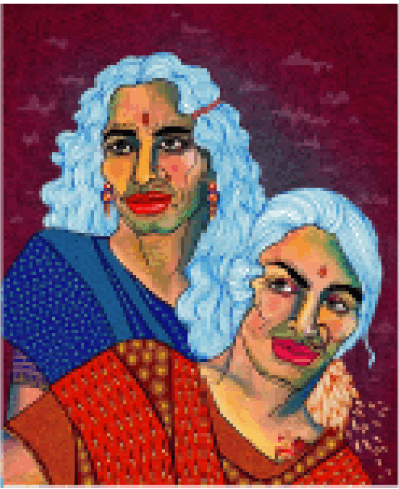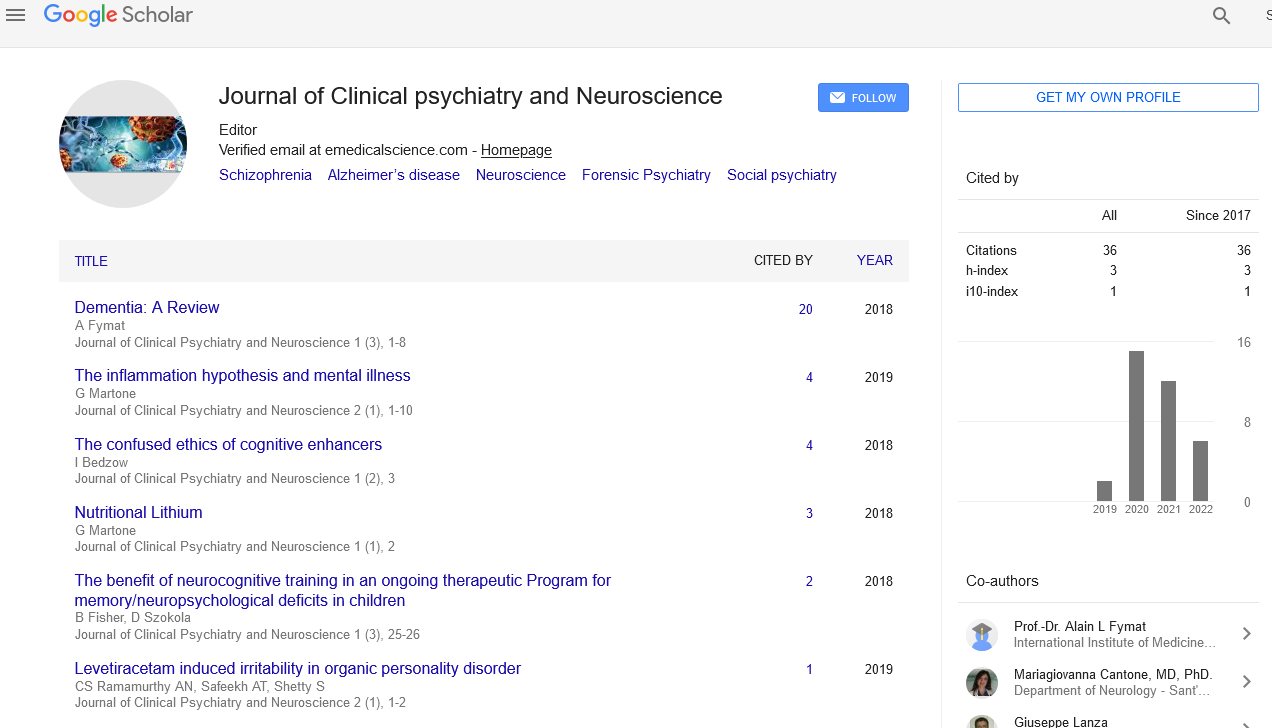Fear of the hijra and their existence: the sad truth of the community and need for change: A case report
Received: 27-Aug-2022, Manuscript No. PULJCPN-22-5294; Editor assigned: 29-Aug-2022, Pre QC No. PULJCPN-22-5294 (PQ); Accepted Date: Sep 26, 2022; Reviewed: 03-Sep-2022 QC No. PULJCPN-22-5294 (Q); Revised: 05-Sep-2022, Manuscript No. PULJCPN-22-5294 (R); Published: 28-Sep-2022, DOI: 10.37532/ puljcpn.2022.5(5).58-61.
Citation: Bhaumik U. Fear of the hijra and their existence-the sad truth of the community and need for change: A case report. J Clin Psychiatry Neurosci. 2022; 5(5):58-61.
This open-access article is distributed under the terms of the Creative Commons Attribution Non-Commercial License (CC BY-NC) (http://creativecommons.org/licenses/by-nc/4.0/), which permits reuse, distribution and reproduction of the article, provided that the original work is properly cited and the reuse is restricted to noncommercial purposes. For commercial reuse, contact reprints@pulsus.com
Abstract
Objectives: Hijras are a unique entity in Southeast Asia, representative of the broader transgender community. They have found mention in history and folklore, where they were held in high esteem and enjoyed a societal importance. The period of British rule in India and the subcontinent of Asia was followed by policies and laws which led to their downfall in stature. In the present world, they have been shunned from mainstream society,
Methods: This study consists of two cases of obsessive-compulsive disorder wherein a common theme in the psychopathology was fear of turning into a hijra, using which the author attempts to explore the lifestyle of an erstwhile powerful community and offers ways to improve their condition.
Results: The common theme in the psychopathology of the two patients appears to be deep-rooted apprehensions of turning into a hijra. They both described that if faced with their dreaded situation they would have to leave their homes and lead an isolated existence with an inability of copulate as a eunuch. They were also of the opinion that they had been cursed by the eunuchs themselves, who were angry at not receiving help and support from them in distress. This shows that despite increased awareness and level of education (both clients were graduates) the patients had a sense of fear and ignorance about the eunuch community.
Conclusions: It is important to frame laws and spread awareness about non-binary genders to help sensitize the society about the identity and way of the living of eunuchs in the community. Steps should be taken so that they are able to receive the necessities of life and enjoy community participation and freedom like others in this current world.
Keywords
Obsessive-compulsive disorder; Fluoxetine
Introduction
Gender is not sane. It's not sane to call a rainbow black and white.” -Kate Bornstein [1]. “Transgender” is as a term used to define indiindividuals whose gender identity or expression differs from the culturally bound gender associated with one’s assigned birth sex (male or female) [2]. Community-dwelling transgenders and intersex are a part of the history of most countries around the world. The word “hijra” is an umbrella term used to describe the socio-religious group of typically transgender women and intersex people who share a long association with of South Asia’s cultural tapestry (including India, Pakistan, Afghanistan and Bangladesh) [3,4]. The word ‘hijra’ is originated from Urdu, derived from the Arabic root ‘hjr' in its sense of ‘leaving one's tribe’[5]. In the past, ‘hijras’ were held in a position of respect. In historical accounts, several of them have been described as courtiers or guardians of harems and were a part of mythology and folklore There is mention of Iravan in Mahabharata, the celebrated Hindu epic who took part in the battle of Kurukshetra.
During his exile, the Pandeva warrior-price Arjuna assumes the identity of a eunuch-transvestite during exile [6,7].
In Hindu mythology, the deity Lord Shiva is portrayed as One with his consort Parvati [8]. Wendy Doniger O’Flaherty in his book ‘Siva: The Erotic Ascetic’ made a comment on Lord Shiva’s ascetic fertility-“ the linga [9]. becomes a source of universal fertility as soon as it has ceased to be a source of individual fertility” [10]. This very reference carries a belief on the position of the hijras who as emasculated men, have the power to bless others with fertility. Beliefs such as this caused hijras to be equally revered and feared over time. The mysterious ways of the hijras are often misunderstood by current mainstream society. They are often harassed, abused, and even victimized and must fight for basic human rights and privileges [11]. They often have to contend with lack of legal support which is unable to see beyond the male-female dichotomy [12]. It becomes a need for the society to accept them as they are and help them to have access to basic rights [13].
This article describes two cases which presented with fear of turning into a hijra, which were successfully treated; it is an attempt to depict the levels of fear society continues to harbour for hijras and the need for drastic and immediate change.
Case Presentation
Here the author describes two young adults presenting with obsessive compulsive disorder presenting with fear of hijras and obsessive apprehension of turning into a hijra themselves. The two cases mentioned in the study were seen in the doctor’s private clinic (Mind Wellness Clinic) located in Kolkata in the eastern part of India in January 2022.The first case was later admitted due to suicidal risk. Oral informed consent was obtained from both the participants before their inclusion into the study.
The first case describes a 29-year-old unmarried male presenting with paranoid doubts of turning into a ‘hijra’ and had to be admitted with high risk of suicide. The doubt of whether his body was ‘changing’ began about two weeks after an incident wherein he was involved with a friend. They had been onlookers to an incident involving some ‘hijras’ who were being harassed by another group of people. They had refused to get involved to help despite requests from the ‘hijras’. Failure to intervene and aid was the reason, according to the case, for getting cursed. It started as a doubt and gradually became obsessive in quality leading to the index admission.
During the interview, he mentioned that he was convinced that he would soon become a hijra and must leave his family, which was due to being cursed by one of them.
His diagnosis was revised to obsessive compulsive disorder with poor insight. He scored 40 out of 45 on Yale-Brown Obsessive Compulsive Symptom Severity Scale. Evaluation of Yale-Brown checklist did not reveal other obsessions or compulsions.
Routine bloodwork did not reveal anything unusual. He was started on routine anti-obsessional treatment and benzodiazepine cover for the agitation. He improved in a month and was keeping well on later outpatient visits for the next three months post which he was lost to follow-up.
The second case describes a 28-year-old male presenting with doubts of losing masculinity and turning into a eunuch after treatment with Fluoxetine. He had first presented with symptoms of obsessive-compulsive disorder with repetitive doubts of where he had spoken ‘correctly’ while talking to others. He was started on Fluoxetine for his symptoms after routine investigations like blood, renal and liver parameters came normal. He scored 35 out of 45 on the Yale-Brown obsessive-compulsive severity scale. YaleBrown symptoms checklist revealed past obsessions related to cleanliness which were no longer bothersome.
When he was seen after a few follow-up sessions, he reported significant improvement (score recorded on Yale-Brown severity scale-10). However, he reported having low desire for masturbation and symptoms suggestive of erectile dysfunction, a common adverse effect seen with Fluoxetine. When he was explained about this, he was unwilling to continue the medication and based on mutually agreed terms, a decision to cross-taper Fluoxetine with Sertraline was made. In the next visit, he presented with doubts that he had become a ‘hijra’, which was a drastic change from his profile of symptoms. When enquired further, he believed he was being punished by God as he had probably refused to give them alms on several occasions. There was no guilt associated with the symptoms. When explained about need to wait due to the long half-life of Fluoxetine, his agitation decreased considerably.
In the next follow-up, his concerns had resolved. He expressed that he had always wary of the ‘hijra’ community as they would often come to him begging and that he had mostly obliged out of fear of being cursed. In a recent incident, he had refused as there was no spare change available. He was doing well when see again after three months after which he dropped out.
Discussion
Both cases presented here were young adult males approaching their thirties and had been diagnosed with obsessive compulsive disorder with high latent anxiety. During the interviews, both revealed that if their fears and suspicions would eventually come true, they would have to shun their community and lead independent lives of their own and would not be able to face their families or mainstream society again. They also expressed guilt, believing that they were being ‘punished’ for their deeds. The first patient felt he should have helped the group of hijras while the second patient believed refusal to give alms to a hijra in the past must have led to his current physical and mental state. There was significant anxiety in both regarding how loss of their virility would affect their future sexual and marital life.
In current literature, there are no reports or study portraying transphobia as psychopathology or presenting with syndromal mental illness.More research is required into this aspect.More importantly, however, is that it depicts the negative attitude society exhibits towards hijras and their way of life. All this comes on the heels of a multitude of changes recognizing third genders as a separate gender identity.
Social lives of hijras
The beliefs of these two individuals sheds some light on how hijras are portrayed and treated in society in India, Pakistan, and Bangladesh. At an early age, some of them may undergo castration as dictated by rituals, but many do not. They typically live in the margins of societies, often in ghettos. They are usually rejected by their families (Figure 1 and 2). Due to discrimination faced in different walks of life like school, college or workplace, they resort to primarily begging for their livelihood [14,15]. On different occasions, they may come uninvited, sing and dance to announce their presence. A significant reason because of which they are not turned away appears to be fear of being cursed by the community [16,17].
Legal issues of hijras
As they are sometimes forced into prostitution, hijras face harassment by police and media as well. After the amendment of the Criminal Tribes Act of 1871 in 1897, the British Government in India decreed that a register with names and residences of eunuchs had to be maintained [18]. This was in view of Sec 377 of the Criminal Procedure Code, intended to prevent forced kidnappings and castrations of children [19]. The law also stripped them of basic privileges such as adopting children [20].
The Immoral Traffic (Prevention) Act of 1956 is also used against the community when majority of ‘hijra’s participating in prostitution do so voluntarily. These laws and acts culminate into documented human rights violations against hijra sex workers from police themselves, including physical and sexual abuse, wrongful confinement, and extortion of money in many cases [21].
Civil law in India also has ignored their rights like voting or having a passport so far, as they were no classifiable into one of the two genders. On the other hand, they would often be victimized due to Section 377 of the Indian Penal Code which declared all forms of unnatural sexual practice as illegal.
Hijras in Pakistan
In the neighbouring country of Pakistan, things not so different. The term ‘hijra’ is often reserved as an abusive term for an effeminate or impotent male. They cannot claim any reservations in jobs or in matters of healthcare. Individuals with gender identity issues are often forced to carry out castrations without any medical and psychological aids. They may indulge in self-remedial measures including hormonal applications without prescriptions, using silicon injections and even auto-castrations on their own. As Islam has negative view of homosexuality, they are usually resigned to a secluded existence, where people do not like speaking to them. A similar picture exists in Bangladesh [22].
Problems faced in seeking healthcare
Till recently, hijras, even after leaving their communities and choosing an independent life, would face challenges in even opting for or undergoing sexual reassignment procedures and basic healthcare services due to paucity of guidelines framed for them by local medical bodies. Forced to go to quacks for these, they would thus place themselves at serious risk of complications.
Health issues among the hijras
Studies on mental health in the hijra community in India has also shown a high prevalence of physical and emotional abuse. A significant proportion also continues to grapple with alcohol and tobacco use. Higher rates of anxiety and mood disorders, has been reporte [23]. Increased prevalence of stressors and life events, poor social support,loneliness,perceived discrimination and maladaptive coping are some of the possible factors which need to be addressed to provide psychological aid to the community [24]. They also have a higher prevalence of medical health issues due to the effects of overcrowding, neglect and professional hazards like sexually transmitted diseases [25].
There promises to be a change in outlook after major court hearings and verdicts globally and more awareness on the hijra community. One significant area of improvement is the establishment of transgender-friendly hospitals where general healthcare as well as sex reassignment treatment options are being made available [26]. A lot more needs to be done for the society to even come close to providing basic rights and privileges to the hijra community.
Some suggestions which may be considered are:
1) The acceptance of transgenders and hijras as ‘third gender’.
2) Modification of laws to empower the hijra and transgender communities.
3) Supporting hijras for education and work at public and private institutions.
4) Form a grievance redressal committee dedicated to working for transgenders in each state.
5) Having transgender-friendly committees in hospitals and listing of health institutions as ‘transgender-friendly.
It is important for police and media to spread and promote awareness on the community and mental health professionals too have an important contributory role.
Conclusion
It is of paramount importance that society starts proving basic privileges to hijras and the transgenders at large so that they can enjoy a safe space. There needs to be a significant change in the way society views hijras and transgenders for the reality to change and from the perspective of the ‘third gender’ one can be hopeful of brighter days to come.
REFERENCES
- Bornstein K, Outlaw G. On men, women and the rest of us, Nueva York.
- Davidson M. Seeking refuge under the umbrella: Inclusion, exclusion, and organizing within the category transgender. Sex Res Soc Policy. 2007;4(4):60-80.
- Nanda S. Neither man nor woman: The hijras of India. Wadsworth Publ;1990.
- Chaudhry S, Reddy G. With Respect to Sex: Negotiating Hijra Identity in South India. New Delhi: Yoda Press. 2006. Indian J Gend Stud. 2010;17(3):482-5.
- Alhawary MT, Benmamoun E. Perspectives on Arabic Linguistics: Volume XVII–XVIII: Alexandria, 2003 and Norman, Oklahoma 2004: Papers from the annual symposium on Arabic linguistics. Lllinois Eperts; 2004.
- Mishra A. Third gender rights: The battle for equality. Christ ULJ.2016;5:9.
- Srinivasan SP, Chandrasekaran S. Transsexualism in hindu mythology. Indian J Endocrinol Metab. 2020;24(3):235.
- Raveesh BN. Ardhanareeshwara concept: Brain and psychiatry. Indian J Psychiatry. 2013;55:S263.
- On men, women and the rest of us, Nueva York
- O’Flaherty, W.D. Asceticism and Sexuality in the Mythology of Śiva. Part I. Hist Relig. 1969; 8(4),300–37.
- Woltmann S. Third Gender Politics: Hijra Identity Construction in India and Beyond. South Asian Rev. 2020;41(1):3-15.
- Jain D, Rhoten KM. Epistemic injustice and judicial discourse on transgender rights in India: Uncovering temporal pluralism. J Hum Values. 2020;26(1):30-49.
- Jami H, Network A. Condition and status of hijras (transgender, transvestites etc.) in Pakistan: Country report.
- Chettiar A. Problems faced by Hijras (male to female transgenders) in Mumbai with reference to their health and harassment by the police. Int J Soc Sci Humanity. 2015;5(9):752.
- Islam A. Right to education of the third gender of Bangladesh: An overview. IOSR J Humanit Soc Sci. 2016;21(9):29-34.
- Saria V. Begging for change: Hijras, law and nationalism. Contributions to Indian Sociology. 2019;53(1):133-57.
- Suleman D, Ab Rahman D. Transgender issues in Indian society from the viewpoint of Arundhati Roy’s novel, the ministry of utmost happiness. South Asian J Soc Sci Humanit. 2020;1(3):159-72.
- Kapadia KM. The criminal tribes of India. Sociol Bull.1952;1(2):99-125.
- Newport SE. ‘Unnatural Offences’, Postcolonial Problems: The ambivalent position of hijras in contemporary Indian law and literature. South Asian Rev. 2017;38(1):87-99.
- Lal V. Not this, not that: The hijras of India and the cultural politics of sexuality. Soc Text. 1999;(61):119-40.
- Sharma SG. Whether Eunuch are Recognised as Legal Entity in India. SSRN. 2008.
- Khan SI, Hussain MI, Parveen S, et al. Living on the extreme margin: social exclusion of the transgender population (hijra) in Bangladesh. J health popul nutr. 2009;27(4):441.
- Gururaj G, Varghese M, Benegal V, et al. National Mental Health Survey of India, 2015–16. NIMHANS Publ. 2016.
- Bhattacharya S, Ghosh D. Studying physical and mental health status among hijra, kothi and transgender community in Kolkata, India. Soc Sci Med. 2020;265:113412.
- Runwal RR, Thakur M, Saini SK, et al. Physical health, life style and health issue among hijra/transgender women: An exploratory study in Chandigarh, India. Nurs Midwifery Res J. 2018;14(2):79-86.
- Bolderston A, Ralph S. Improving the health care experiences of lesbian, gay, bisexual and transgender patients. Radiography. 2016;22(3):207-11.







